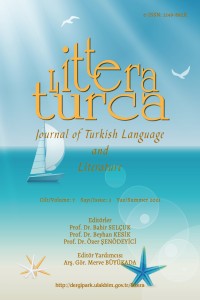Öz
19. yüzyılda Osmanlı müelliflerinin çoğu batı edebiyatından yaptıkları tercümeleri matbaada bastırırken bazısı da bu tür eserleri el ile yazıp çoğaltmıştır. Hâfız İbrahim Edhem Efendi’nin Aisopos hikâyelerinin Türkçeye tercümesine dayanan Nevâdirü’l-emsâl adlı eseri yazma olarak telif edilmiştir. Ali Ağa adlı bir esnafın oğlu olan Hâfız İbrahim Edhem Efendi 18 Zilhicce 1225’te (14 Ocak 1811) İstanbul’da doğdu. Küçük yaşta Kur’ân-ı Kerîm’i ezberleyip kâtiplik sanatını öğrendi. Vak‘anüvîs Mehmed Es‘ad Efendi’nin yanında kâtiplik yaptı. Anadolu’da kadılık ve tercüme odasında tercümanlık görevlerinde bulundu. Nevâdirü’l-emsâl’de yer alan manzumelerden onun Türk, Fars ve Arap dillerinde şiir yazma kudretine sahip bir şair olduğu anlaşılmaktadır. Ünik nüshası Leipzig Üniversite Kütüphanesi Cod. Turc. 047 numarada kayıtlı olan Nevâdirü’l-emsâl’in yazılış tarihi belli değildir. Müellif nüshadan çıkartılmış ikinci kopya olan mevcut nüsha 1259 Zilka‘de (Kasım/Aralık 1843) tarihlidir. Bu yüzden Nevâdirü’l-emsâl 1259/1843 senesinde veya bundan kısa bir zaman önce yazılmış olmalıdır. Sultan Abdülmecid b. Sultan Mahmud’a sunulan Nevâdirü’l-emsâl’de doksan bir hikâye vardır. Bunlardan seksen dokuzu mensur, ikisi manzum biçimde tercüme edilmiştir. Hikayeler; başlık, olay, kıssadan hisse ve manzume bölümlerinden meydana gelmiştir. Hâfız İbrahim Edhem Efendi dibacede münşiyâne üslûbu değil, çağının ifadeye dayalı yalın anlatımını tercih edeceğini belirtmektedir. Ancak Nevâdirü’l-emsâl’in dil ve üslûbu klasik dönem Osmanlı nesir dili özelliklerini yansıtmaktadır. Bu makalede Hâfız İbrahim Edhem Efendi’nin edebiyat tarihi kaynaklarımızda söz edilmeyen Nevâdirü’l-emsâl adlı eseri ilim âlemine tanıtılmış, örneklem oluşturması maksadıyla eserin dibacesi ile ilk hikâyesinin çeviri yazılı metnine yer verilmiştir.
Anahtar Kelimeler
Kaynakça
- Arslan, Mehmet (07.04.2021). “AHSEN/HÂFIZ, Hâfız İbrahim Edhem Efendi”, Türk Edebiyatı İsimler Sözlüğü, http://teis.yesevi.edu.tr/madde-detay/ahsen-hafiz-hafiz-ibrahim-edhem
- İsen, Mustafa (06.04.2021). "Bağçe-i Safâ-endûz", TDV İslâm Ansiklopedisi, https://islamansiklopedisi.org.tr/bagce-i-safa-enduz
- Kavruk, Hasan ve Pala, İskender (1998). "Hikaye (Divan Edebiyatı)", TDV İslâm Ansiklopedisi, C. 29, s. 491-493. Ankara: TDV Yayınları.
- Kut, Turgut (05.04.2021). "Dârüttıbâa", TDV İslâm Ansiklopedisi, https://islamansiklopedisi.org.tr/daruttibaa
- Mutçalı, Serdar (1995). Arapça-Türkçe Sözlük, İstanbul: Dağarcık Yayınları.
- Oğraş, Rıza (2001). Esad Mehmed Efendi ve Bağçe-i Safâ-endûz’u, Burdur: Kültür Bakanlığı Yayınları.
- Soydaş, Hakan (2019). “Türkçeye Çevrilen İlk Fabl Antolojisi Choix De Fables Traduite En Turk/Emsâl-i Güzîde”, Doğu Batı Düşünce Dergisi, Yıl 22, Sayı 88, Şubat, Mart, Nisan, s. 117-149.
- Sucu, Nurgül (2006). “Eski Türk Edebiyatında Tercüme Geleneği”, Selçuk Üniversitesi Türkiyat Araştırmaları Dergisi, Sayı 19, s. 125-148.
- Tuman, Mehmet Nail (2001). Tuhfe-i Nâilî Divan Şairlerinin Muhtasar Biyografileri, (haz.) Cemal Kurnaz, Mustafa Tatçı, Ankara: Bizim Büro Yayınları.
- Ünver, İsmail (2004). "Mesnevi (Türk Edebiyatı)", TDV İslâm Ansiklopedisi, C. 29, s. 322-324. Ankara: TDV Yayınları.
- Yazıcı, Hüseyin (1998). "Hikaye", TDV İslâm Ansiklopedisi, C. 17, s. 479-485. Ankara: TDV Yayınları.
- Yılmazer, Ziya (06.04.2021). "ESAD EFENDİ, Sahaflar Şeyhizâde", TDV İslâm Ansiklopedisi, https://islamansiklopedisi.org.tr/esad-efendi-sahaflar-seyhizade
Öz
In the 19th century, most of the Ottoman authors printed their translations from western literature in the printing house, while some of them wrote and reproduced such works by hand. The work named Nevâdirü'l-emsâl by Hafız İbrahim Edhem Efendi based on the Turkish translation of the stories of Aisopos was copyrighted as a manuscript. Hafız İbrahim Edhem Efendi, the son of a shopkeeper named Ali Ağa, was born on 18 Zilhicce 1225 (January 14, 1811) in Istanbul. He learned the art of clerk by memorizing the Holy Quran at a young age. He worked as a clerk next to Vak‘anüvîs Mehmed Es‘ad Efendi. He worked as a judge in Anatolia and interpreter in the translation room. It is understood from the poems in Nevâdirü'l-emsâl that he is a poet who has the power to write poetry in Turkish, Persian and Arabic languages. The date of writing of Nevâdirü'l-emsâl, whose unique manuscript is registered at Leipzig University Library number Cod. Turc. 047, is not known. The current copy, the second copy removed from the author's copy, is dated 1259 Zilka‘de (November / December 1843). Therefore, Nevâdirü'l-emsâl must have been written in 1259/1843 or a short time ago. There are ninety-one stories in Nevâdirü'l-emsâl presented to Sultan Abdülmecid b. Sultan Mahmud. Eighty-nine of them have been translated in prose and two in verse. Stories; It consists of the title, event, advice and poetry sections. Hafız İbrahim Edhem Efendi states in the preface that he would prefer the plain expression of his age, not the münşiyâne style. However, the language and style of Nevâdirü'l-emsâl reflects the characteristics of the classical period Ottoman prose language. In this article, Hâfız İbrahim Edhem Efendi's work named Nevâdirü'l-emsâl, which is not mentioned in our literature history resources, was introduced to the world of science, and the preface of the work and the translated text of the first story were included in order to serve as an example.
Anahtar Kelimeler
Kaynakça
- Arslan, Mehmet (07.04.2021). “AHSEN/HÂFIZ, Hâfız İbrahim Edhem Efendi”, Türk Edebiyatı İsimler Sözlüğü, http://teis.yesevi.edu.tr/madde-detay/ahsen-hafiz-hafiz-ibrahim-edhem
- İsen, Mustafa (06.04.2021). "Bağçe-i Safâ-endûz", TDV İslâm Ansiklopedisi, https://islamansiklopedisi.org.tr/bagce-i-safa-enduz
- Kavruk, Hasan ve Pala, İskender (1998). "Hikaye (Divan Edebiyatı)", TDV İslâm Ansiklopedisi, C. 29, s. 491-493. Ankara: TDV Yayınları.
- Kut, Turgut (05.04.2021). "Dârüttıbâa", TDV İslâm Ansiklopedisi, https://islamansiklopedisi.org.tr/daruttibaa
- Mutçalı, Serdar (1995). Arapça-Türkçe Sözlük, İstanbul: Dağarcık Yayınları.
- Oğraş, Rıza (2001). Esad Mehmed Efendi ve Bağçe-i Safâ-endûz’u, Burdur: Kültür Bakanlığı Yayınları.
- Soydaş, Hakan (2019). “Türkçeye Çevrilen İlk Fabl Antolojisi Choix De Fables Traduite En Turk/Emsâl-i Güzîde”, Doğu Batı Düşünce Dergisi, Yıl 22, Sayı 88, Şubat, Mart, Nisan, s. 117-149.
- Sucu, Nurgül (2006). “Eski Türk Edebiyatında Tercüme Geleneği”, Selçuk Üniversitesi Türkiyat Araştırmaları Dergisi, Sayı 19, s. 125-148.
- Tuman, Mehmet Nail (2001). Tuhfe-i Nâilî Divan Şairlerinin Muhtasar Biyografileri, (haz.) Cemal Kurnaz, Mustafa Tatçı, Ankara: Bizim Büro Yayınları.
- Ünver, İsmail (2004). "Mesnevi (Türk Edebiyatı)", TDV İslâm Ansiklopedisi, C. 29, s. 322-324. Ankara: TDV Yayınları.
- Yazıcı, Hüseyin (1998). "Hikaye", TDV İslâm Ansiklopedisi, C. 17, s. 479-485. Ankara: TDV Yayınları.
- Yılmazer, Ziya (06.04.2021). "ESAD EFENDİ, Sahaflar Şeyhizâde", TDV İslâm Ansiklopedisi, https://islamansiklopedisi.org.tr/esad-efendi-sahaflar-seyhizade
Ayrıntılar
| Birincil Dil | Türkçe |
|---|---|
| Bölüm | Makaleler |
| Yazarlar | |
| Yayımlanma Tarihi | 31 Temmuz 2021 |
| Gönderilme Tarihi | 5 Haziran 2021 |
| Yayımlandığı Sayı | Yıl 2021 Cilt: 7 Sayı: 3 |
Kaynak Göster
İlgi, katkı ve desteğiniz için teşekkür eder, iyi çalışmalar dileriz.







